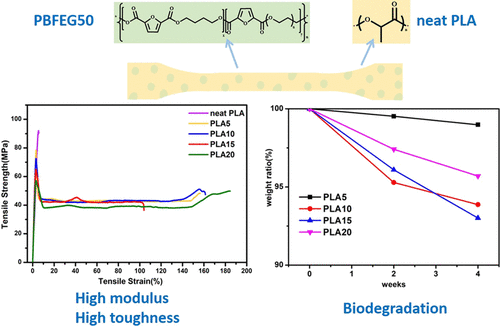当前位置:
X-MOL 学术
›
Biomacromolecules
›
论文详情
Our official English website, www.x-mol.net, welcomes your feedback! (Note: you will need to create a separate account there.)
Toughening Polylactic Acid by a Biobased Poly(Butylene 2,5-Furandicarboxylate)-b-Poly(Ethylene Glycol) Copolymer: Balanced Mechanical Properties and Potential Biodegradability
Biomacromolecules ( IF 6.2 ) Pub Date : 2020-12-23 , DOI: 10.1021/acs.biomac.0c01236 Chao Chen 1, 2 , Ying Tian 1, 2 , Fenglong Li 1, 2 , Han Hu 1, 2 , Kai Wang 1 , Zhengyang Kong 1 , Wu Bin Ying 1 , Ruoyu Zhang 1 , Jin Zhu 1
Biomacromolecules ( IF 6.2 ) Pub Date : 2020-12-23 , DOI: 10.1021/acs.biomac.0c01236 Chao Chen 1, 2 , Ying Tian 1, 2 , Fenglong Li 1, 2 , Han Hu 1, 2 , Kai Wang 1 , Zhengyang Kong 1 , Wu Bin Ying 1 , Ruoyu Zhang 1 , Jin Zhu 1
Affiliation

|
Polylactic acid (PLA) is a biodegradable thermoplastic polyester produced from natural resources. Because of its brittleness, many tougheners have been developed. However, traditional toughening methods cause either the loss of modulus and strength or the lack of degradability. In this work, we synthesized a biobased and potentially biodegradable poly(butylene 2,5-furandicarboxylate)-b-poly(ethylene glycol) (PBFEG50) copolymer to toughen PLA, with the purpose of both keeping mechanical strength and enhancing the toughness. The blend containing 5 wt % PBFEG50 exhibited about 28.5 times increase in elongation at break (5.5% vs 156.5%). At the same time, the tensile modulus even strikingly increased by 21.6% while the tensile strength was seldom deteriorated. Such a phenomenon could be explained by the stretch-induced crystallization of the BF segment and the interconnected morphology of PBFEG50 domains in PLA5. The Raman spectrum was used to identify the phase dispersion of PLA and PBFEG50 phases. As the PBFEG50 content increased, the interconnected PBFEG50 domains start to separate, but their size increases. Interestingly, tensile-induced cavitation could be clearly identified in scanning electron microscopy images, which meant that the miscibility between PLA and PBFEG50 was limited. The crystallization of PLA/PBFEG50 blends was examined by differential scanning calorimetry, and the plasticizer effect of the EG segment on the PLA matrix could be confirmed. The rheological experiment revealed decreased viscosity of PLA/PBFEG50 blends, implying the possible greener processing. Finally, potential biodegradability of these blends was proved.
中文翻译:

通过生物基聚(2,5-呋喃二甲酸丁二酯)-b-聚(乙二醇)共聚物增韧聚乳酸:平衡的机械性能和潜在的生物降解性
聚乳酸(PLA)是由自然资源生产的可生物降解的热塑性聚酯。由于其脆性,已经开发了许多增韧剂。但是,传统的增韧方法导致模量和强度的损失或缺乏可降解性。在这项工作中,我们合成了一种可生物降解的生物基聚(2,5-呋喃二甲酸丁二醇酯)-b-聚(乙二醇)(PBFEG50)共聚物可增韧PLA,目的是既保持机械强度又提高韧性。包含5重量%PBFEG 50的共混物表现出约28.5倍的断裂伸长率增加(5.5%对156.5%)。同时,拉伸模量甚至显着增加了21.6%,而拉伸强度很少降低。这种现象可以通过拉伸诱导的BF段的结晶以及PLA5中PBFEG50域的相互连接的形态来解释。拉曼光谱用于鉴定PLA和PBFEG50相的相分散。随着PBFEG50含量的增加,互连的PBFEG50域开始分离,但它们的大小增加。有趣的是,在扫描电子显微镜图像中可以清楚地识别出拉伸引起的气穴现象,这意味着PLA与PBFEG50之间的互溶性受到限制。通过差示扫描量热法检查了PLA / PBFEG50共混物的结晶,并证实了EG段对PLA基质的增塑作用。流变实验表明,PLA / PBFEG50共混物的粘度降低,这意味着可能进行更绿色的加工。最后,证明了这些共混物的潜在生物降解性。
更新日期:2021-02-08
中文翻译:

通过生物基聚(2,5-呋喃二甲酸丁二酯)-b-聚(乙二醇)共聚物增韧聚乳酸:平衡的机械性能和潜在的生物降解性
聚乳酸(PLA)是由自然资源生产的可生物降解的热塑性聚酯。由于其脆性,已经开发了许多增韧剂。但是,传统的增韧方法导致模量和强度的损失或缺乏可降解性。在这项工作中,我们合成了一种可生物降解的生物基聚(2,5-呋喃二甲酸丁二醇酯)-b-聚(乙二醇)(PBFEG50)共聚物可增韧PLA,目的是既保持机械强度又提高韧性。包含5重量%PBFEG 50的共混物表现出约28.5倍的断裂伸长率增加(5.5%对156.5%)。同时,拉伸模量甚至显着增加了21.6%,而拉伸强度很少降低。这种现象可以通过拉伸诱导的BF段的结晶以及PLA5中PBFEG50域的相互连接的形态来解释。拉曼光谱用于鉴定PLA和PBFEG50相的相分散。随着PBFEG50含量的增加,互连的PBFEG50域开始分离,但它们的大小增加。有趣的是,在扫描电子显微镜图像中可以清楚地识别出拉伸引起的气穴现象,这意味着PLA与PBFEG50之间的互溶性受到限制。通过差示扫描量热法检查了PLA / PBFEG50共混物的结晶,并证实了EG段对PLA基质的增塑作用。流变实验表明,PLA / PBFEG50共混物的粘度降低,这意味着可能进行更绿色的加工。最后,证明了这些共混物的潜在生物降解性。


























 京公网安备 11010802027423号
京公网安备 11010802027423号